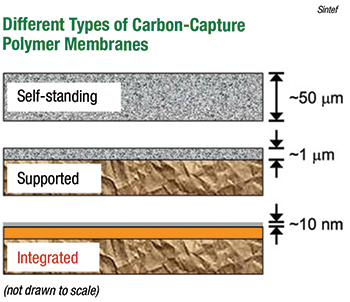Conventional gas-separation membranes normally exhibit a trade-off between selectivity and permeability — a practical limitation referred to as the Robeson upper bound. As a result, membranes designed to selectively remove relatively low concentrations of carbon dioxide from natural gas or fluegas are inherently hampered by a low CO2 flux through the membrane.
To overcome this constraint, researchers from Sintef (Trondheim, Norway; www.sintef.no), in collaboration with professor Richard Spontak at North Carolina State University (Raleigh; www.ncsu.edu) and professor Liyuan Deng at the Norwegian University of Science and Technology (Trondheim; www.ntou.no), have developed membranes that integrate an ultrathin, highly CO2-selective surface layer with a highly permeable, but low selectivity, polymer membrane in a concept referred to as hybrid-integrated (HI) membrane technology (diagram). As described in a recent article in Science, the surface layer consists of surface-grown polyamines that concentrate CO2 from the target gas stream. The CO2 is quickly transported through the dense polymer membrane and the underlying macroporous support. “The resulting membranes retain high CO2 permeability with CO2 selectivities increased by more than 150-fold over the parent membranes,” says Marius Sandru, Sintef researcher and lead author of the study.

In laboratory-scale tests, performed using membranes with ~20 cm2 area and gas flowrates of ~30 L/h (fully humidified 10/90 CO2/N2 feed typical of fluegas), CO2 permeabilities and CO2/N2 selectivities of up to ~1,000 Barrer and ~1,000, respectively, have been measured. The membranes have also been studied using mixtures of CH4 and CO2 (typical of biogas plants), achieving selectivities of up to ~500.
“The next stage is the stepwise upscaling of membrane area,” says Sandru. Membranes with 500-cm2 area will be fabricated in the ongoing CO2-Hybrid project and tested using real fluegas in static tests, followed by field testing in a coal-/natural gas-fired Waste2Energy pilot facility. The goal is to achieve a 90% CO2 capture efficiency with 95% CO2 purity.